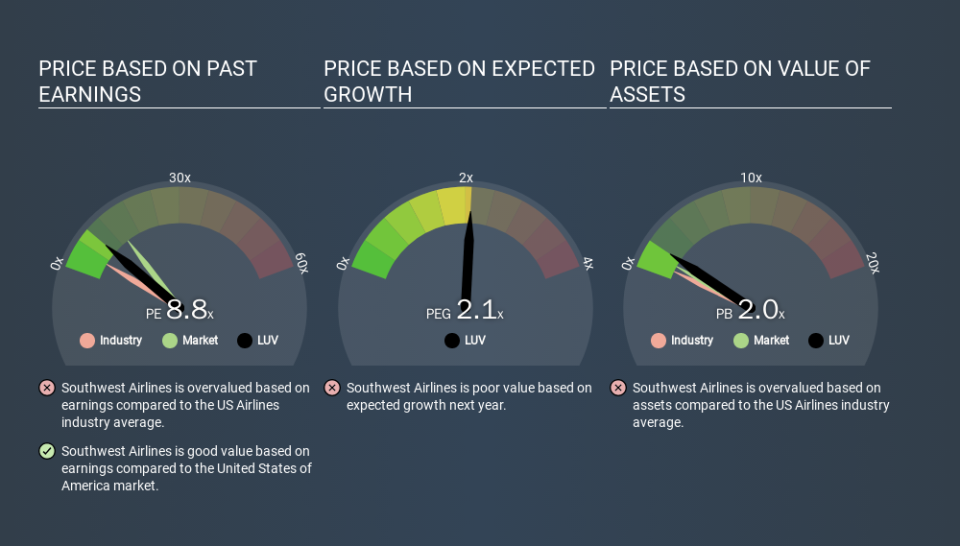What Is Southwest Airlines's (NYSE:LUV) P/E Ratio After Its Share Price Tanked?

Unfortunately for some shareholders, the Southwest Airlines (NYSE:LUV) share price has dived 35% in the last thirty days. The recent drop has obliterated the annual return, with the share price now down 26% over that longer period.
Assuming nothing else has changed, a lower share price makes a stock more attractive to potential buyers. In the long term, share prices tend to follow earnings per share, but in the short term prices bounce around in response to short term factors (which are not always obvious). The implication here is that long term investors have an opportunity when expectations of a company are too low. Perhaps the simplest way to get a read on investors' expectations of a business is to look at its Price to Earnings Ratio (PE Ratio). Investors have optimistic expectations of companies with higher P/E ratios, compared to companies with lower P/E ratios.
Check out our latest analysis for Southwest Airlines
How Does Southwest Airlines's P/E Ratio Compare To Its Peers?
We can tell from its P/E ratio of 8.78 that there is some investor optimism about Southwest Airlines. The image below shows that Southwest Airlines has a higher P/E than the average (4.2) P/E for companies in the airlines industry.
That means that the market expects Southwest Airlines will outperform other companies in its industry. Clearly the market expects growth, but it isn't guaranteed. So investors should always consider the P/E ratio alongside other factors, such as whether company directors have been buying shares.
How Growth Rates Impact P/E Ratios
Generally speaking the rate of earnings growth has a profound impact on a company's P/E multiple. If earnings are growing quickly, then the 'E' in the equation will increase faster than it would otherwise. That means even if the current P/E is high, it will reduce over time if the share price stays flat. So while a stock may look expensive based on past earnings, it could be cheap based on future earnings.
Southwest Airlines's earnings per share were pretty steady over the last year. But EPS is up 21% over the last 5 years.
A Limitation: P/E Ratios Ignore Debt and Cash In The Bank
The 'Price' in P/E reflects the market capitalization of the company. Thus, the metric does not reflect cash or debt held by the company. Theoretically, a business can improve its earnings (and produce a lower P/E in the future) by investing in growth. That means taking on debt (or spending its cash).
While growth expenditure doesn't always pay off, the point is that it is a good option to have; but one that the P/E ratio ignores.
Southwest Airlines's Balance Sheet
With net cash of US$2.0b, Southwest Airlines has a very strong balance sheet, which may be important for its business. Having said that, at 10% of its market capitalization the cash hoard would contribute towards a higher P/E ratio.
The Verdict On Southwest Airlines's P/E Ratio
Southwest Airlines trades on a P/E ratio of 8.8, which is below the US market average of 12.7. Falling earnings per share are likely to be keeping potential buyers away, but the net cash position means the company has time to improve: if so, the low P/E could be an opportunity. What can be absolutely certain is that the market has become more pessimistic about Southwest Airlines over the last month, with the P/E ratio falling from 13.6 back then to 8.8 today. For those who prefer invest in growth, this stock apparently offers limited promise, but the deep value investors may find the pessimism around this stock enticing.
Investors have an opportunity when market expectations about a stock are wrong. If the reality for a company is not as bad as the P/E ratio indicates, then the share price should increase as the market realizes this. So this free visual report on analyst forecasts could hold the key to an excellent investment decision.
Of course, you might find a fantastic investment by looking at a few good candidates. So take a peek at this free list of companies with modest (or no) debt, trading on a P/E below 20.
If you spot an error that warrants correction, please contact the editor at editorial-team@simplywallst.com. This article by Simply Wall St is general in nature. It does not constitute a recommendation to buy or sell any stock, and does not take account of your objectives, or your financial situation. Simply Wall St has no position in the stocks mentioned.
We aim to bring you long-term focused research analysis driven by fundamental data. Note that our analysis may not factor in the latest price-sensitive company announcements or qualitative material. Thank you for reading.

 Yahoo Movies
Yahoo Movies 

